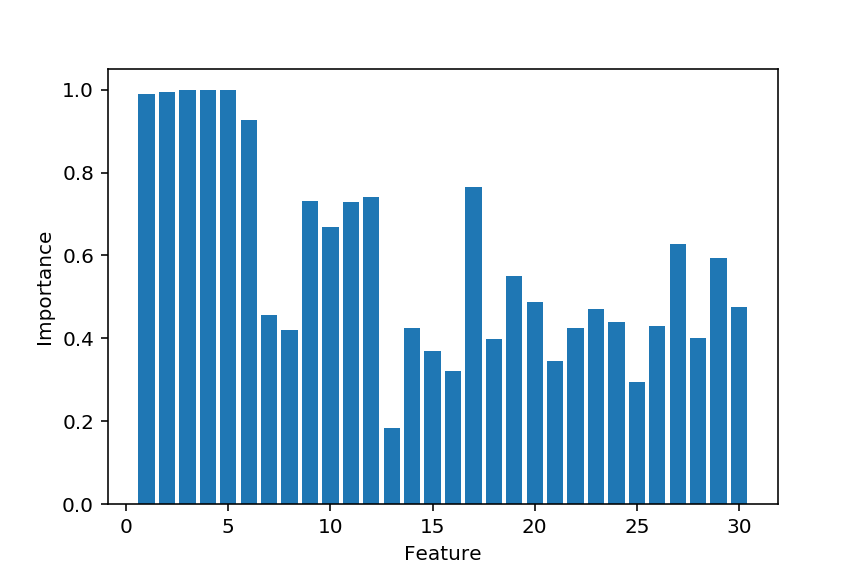A quick experiment to see if its feasible to use simulated annealing for feature selection.
Given an estimator, the process starts out with a random selection of features to use, and then for each step, a feature is toggled on or off at random.
If the estimator performs better with the new set of features, it is taken as the starting point for the next step. If it performs worse, the old set of features is probably kept, but with a small probability — depending on how much worse it performed — the new set might still be accepted in order to avoid getting stuck in a local minimum.
The probability of accepting a set of features that performed worse decreases with each time steps (as the process "cools down") to try and make sure it will eventually settle on a good solution.
pip install git+https://github.com/chrka/rwfs.gitBasic usage (for an estimator, and a cv object, on a feature set X
with targets y):
from rwfs import RandomWalkFeatureSelection
fs = RandomWalkFeatureSelection(estimator, cv, n_steps)
fs.fit(X, y)
X_important = fs.transform(X)-
estimator(object): A supervised learning estimator with ascoremethod. -
cv(cross-validation generator): Determines the cross-validation splitting strategy. -
n_steps(int): Number of steps. -
initial_fraction(float): Fraction of features to include in initial state. -
temperature(float): Initial temperature.-
A higher temperature means larger probabilty of accepting a set of features with worse performance.
-
The best value is dependent on the scale of the scores.
-
-
cooldown_factor(float): Determines how fast the temperature decreases.- Each time step the temperature is multiplied by this to get the new temperature.
-
cache_scores(bool): If true, cache evaluations for feature sets.- This can speed up the process considerably, but is less robust to scores with high variance. Do not use unless you are very sure of your CV accuracy.
-
agg(function): Function to aggregate CV scores at each step.- Can be useful, for example, to take the min instead of the mean in order to to be more conservative when comparing feature sets.
-
gamma(float): Exponential decay factor for feature importances.
-
best_score_(float): CV score when evaluating best set of features found. -
best_features_(np.array of bool) Features found that resulted in the best score.- Represented as an array of bool:s, True if the feature is in the set, False if not.
-
feature_importances(np.array of float): Importance of each feature.- Given by the fraction of accepted feature sets a feature has been part of, weighted exponentially giving more weight to more recent steps.
-
diagnostics_ (dict): Statistics collected during the process:
- features : feature set being evaluated - feature_count : number of features in the set - scores : CV scores - score : aggregated CV score - mean-score : mean CV score - runs : number of evaluations of estimator - std : standard deviation of CV score - se : standard error of CV score
(For a more realistic example, see this Kaggle notebook) using data from the NFL Big Data Bowl competition
Let's set up a small example of linear regression where we have a number of relevant features, and some that are purely noise.
import numpy as np
N_OBSERVATIONS = 10000
N_RELEVANT = 6
N_NOISE = 24
# Generate non-zero coefficients
coeffs = np.random.randint(1, 10, size=N_RELEVANT)
coeffs *= np.random.choice((-1, 1), size=N_RELEVANT)
X = np.random.uniform(-10, 10, size=(N_OBSERVATIONS, N_RELEVANT + N_NOISE))
y = np.sum(X[:, :N_RELEVANT] * coeffs, axis=1)
# Add some extra noise to everything
y += np.random.normal(0, 10, size=y.shape)Let's use the linear regressor from scikit-learn, and then apply RWFS to the problem:
from sklearn.linear_model import LinearRegression
from sklearn.model_selection import ShuffleSplit
from rwfs import RandomWalkFeatureSelection
model = LinearRegression(fit_intercept=False)
cv = ShuffleSplit(n_splits=10, test_size=0.25)
rwfs = RandomWalkFeatureSelection(model, cv,
n_steps=1000,
initial_fraction=0.5,
temperature=1e-1,
cache_scores=False,
agg=np.mean,
gamma=0.99)
rwfs.fit(X, y, verbose=0)If we evaluate the result
>>> rwfs.best_score_
0.9874073607905558
>>> rwfs.best_features_
(True, True, True, True, True, True, False, False, True, False, True, False,
True, False, False, False, False, False, False, False, False, False, True,
False, True, False, False, False, True, True)
And we see that the six relevant features are all found in the best scoring feature set, but there are also some spurious noisy ones.
Looking at the feature importances we see that we get only the relevant ones if we make a cut at about 0.8–0.9:
This software is released under the MIT license (see LICENSE).
